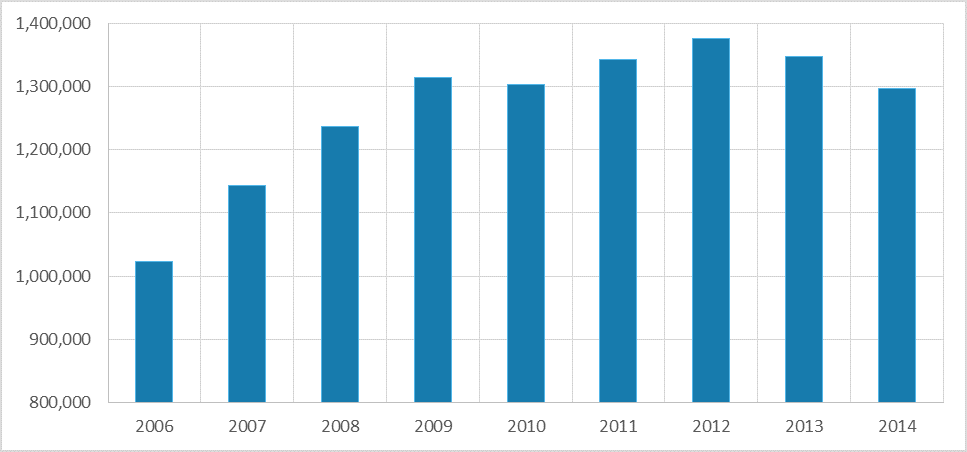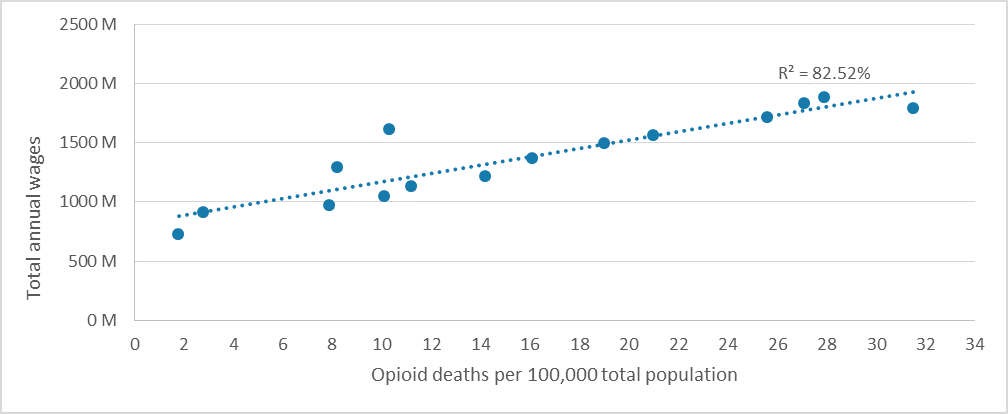Opioid Crisis at the State Level: What's the Cost?
July 17, 2018 •Olivia Hebner

 Since 2017, Summit has been closely monitoring the opioid litigation landscape, including multi-district litigation (MDL) through various outlets. For example, we are tracking more than 30 opioid cases in the state of West Virginia. Our team calculated the supply of opioids, opioid deaths, and the impact of the opioid epidemic on state budgets through the increase of total salaries in the heavily impacted professions.1 These professions include medical services, social services, and law enforcement services.
Since 2017, Summit has been closely monitoring the opioid litigation landscape, including multi-district litigation (MDL) through various outlets. For example, we are tracking more than 30 opioid cases in the state of West Virginia. Our team calculated the supply of opioids, opioid deaths, and the impact of the opioid epidemic on state budgets through the increase of total salaries in the heavily impacted professions.1 These professions include medical services, social services, and law enforcement services.
Figure 1 shows the amount of opioids supplied to West Virginia from 2006 to 2014.
Figure 1: Total opioids supplied, in grams (2006–2014)

Note: Figure 1 was created using ARCOS Report 2 for each year. The drugs included in the calculation were fentanyl, hydrocodone, hydromorphone, meperidine (pethidine), methadone, morphine, and oxycodone. https://www.deadiversion.usdoj.gov/arcos/retail_drug_summary/index.html.
Figure 2 shows the opioid deaths per 100,000 total population in West Virginia from 1999 to 2014. The trend line shows that the number of opioid deaths has been increasing since 1999 and hit a peak of 31.6 deaths per 100,000 total population in 2014.
Figure 2: Total opioid deaths per 100,000 total population (1999–2014)

Note: Figure 2 was created using CDC drug overdose data: https://www.cdc.gov/nchs/pressroom/sosmap/drug_poisoning_mortality/drug_poisoning.htm. The labor categories impacted by the opioid crisis include medical services, social services, and law enforcement services. Total annual wages were adjusted for inflation using the 1999 CPI as the base.
Figure 3 shows the total annual wages in West Virginia for the years 1999 to 2014 for industries impacted by the opioid crisis. As we see in Figure 3, wages have increased over time. But using same data, it is unclear whether we can attribute any of this increase in wages to the opioid epidemic. To make that connection, we can use regression modeling to isolate the correlation of any one factor—like opioid deaths—on wages, then test whether it is statistically significant. These preliminary results can be strengthened by controlling for additional factors, such as economic growth.
Figure 3: Total annual wages for impacted industries (1999–2014)

The regression analysis shows us that the increase in opioid deaths is correlated with an increase in wages and the correlation is statistically significant. In fact, a one-point increase in opioid deaths (per 100,000 total population) increases the next year’s total annual wages by $35,288 (see Figure 4).2 Additionally, opioid deaths explain about 83% of the increase in wages. In addition to influencing total wages, opioid deaths also increase (at a statistically significant rate) each of the impacted labor industries. In fact, opioid deaths explain 76%-86% of the increase in these impacted labor wages.
Figure 4: Predicting wages using opioid deaths from the previous year

1 These statistics were created using data compiled from the Center for Disease Control (CDC), the U.S. Drug Enforcement Administration (DEA), Automated Comprehensive Drug Reporting System (ARCOS) and the Bureau of Labor Statistics (BLS) Quarterly Census of Employment and Wages (QCEW).
2 Due to the inaccurate data in 2005 and 2009, this model produces a conservative estimate. When removing 2005 and 2009, a one-point increase in opioid deaths (per 100,000 total population) increases the next year’s total annual wages by $38,871. https://www.theguardian.com/society/ng-interactive/2016/may/25/opioid-epidemic-overdose-deaths-map.
Summit’s Litigation Analytics team specializes in supporting counsel and expert witnesses in various matters involving data and analytics.
If you’re interested in how Summit can support you and your team, please contact Corey West at corey.west@summitllc.us.
Get Updates
Featured Articles
Categories
- affordable housing (12)
- agile (3)
- AI (4)
- budget (3)
- change management (1)
- climate resilience (5)
- cloud computing (2)
- company announcements (15)
- consumer protection (3)
- COVID-19 (7)
- data analytics (82)
- data science (1)
- executive branch (4)
- fair lending (13)
- federal credit (36)
- federal finance (7)
- federal loans (7)
- federal register (2)
- financial institutions (1)
- Form 5500 (5)
- grants (1)
- healthcare (17)
- impact investing (12)
- infrastructure (13)
- LIBOR (4)
- litigation (8)
- machine learning (2)
- mechanical turk (3)
- mission-oriented finance (7)
- modeling (9)
- mortgage finance (10)
- office culture (26)
- opioid crisis (5)
- Opportunity Finance Network (4)
- opportunity zones (12)
- partnership (15)
- pay equity (5)
- predictive analytics (15)
- press coverage (3)
- program and business modernization (7)
- program evaluation (29)
- racial and social justice (8)
- real estate (2)
- risk management (10)
- rural communities (9)
- series - loan monitoring and AI (4)
- series - transforming federal lending (3)
- strength in numbers series (9)
- summer interns (7)
- taxes (7)
- thought leadership (4)
- white paper (15)


